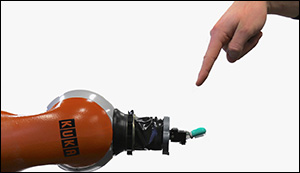Researchers Teaching Robots to Feel and React to Pain
25. 5. 2016 | IEEE Spectrum | spectrum.ieee.org
One of the most useful things about robots is that they don’t feel pain. Because of this, we have no problem putting them to work in dangerous environments or having them perform tasks that range between slightly unpleasant and definitely fatal to a human. And yet, a pair of German researchers believes that, in some cases, feeling pain might be a good capability for robots to have.
The researchers, from Leibniz University of Hannover, are developing an “artificial robot nervous system to teach robots how to feel pain” and quickly react in order to avoid potential damage to their motors, gears, and electronics.

Why is it a good idea for robots to feel pain? The same reason why it’s a good idea for humans to feel pain, said Johannes Kuehn, one of the researchers. “Pain is a system that protects us,” he said. “When we evade from the source of pain, it helps us not get hurt.” Humans that don’t have the ability to feel pain get injured far more often, because their bodies don’t instinctively react to things that hurt them.
Kuehn, who worked on the project with Professor Sami Haddadin, one of the world’s foremost experts in physical human-robot interaction and safety, argues that by protecting robots from damage, their system will be protecting humans as well.
Read more at IEEE Spectrum
Image Credit: Leibniz University of Hannover
-jk-




